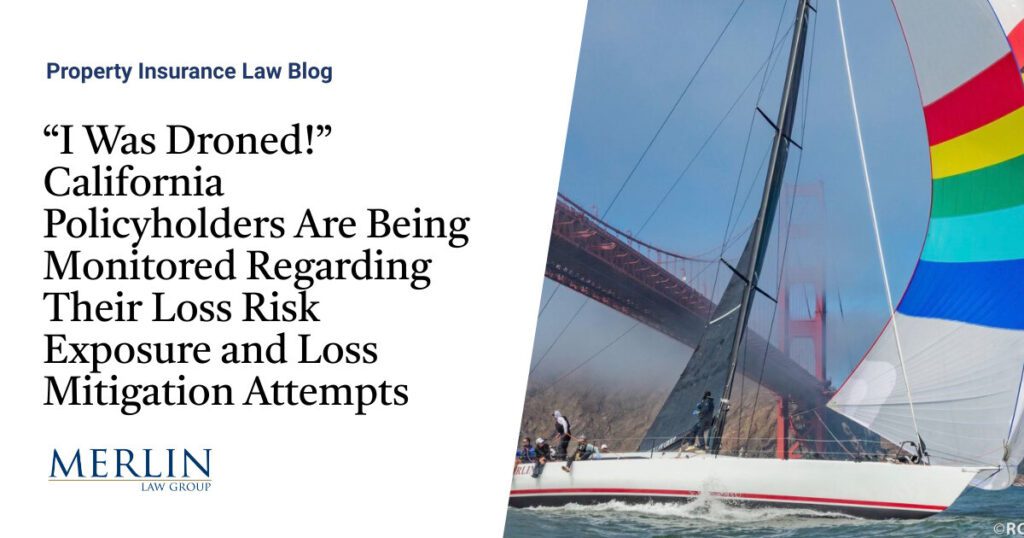“I Was Droned!” California Policyholders Are Being Monitored Regarding Their Loss Risk Exposure and Loss Mitigation Attempts

When I am finished beating up or getting beaten upon by various insurance company attorneys all over the country, I love to compete and beat up or get beaten upon by the best sailboat racers. I love true competition, and it is one reason why I love being the type of attorney that I am for my policyholder clients and leading a team of like-minded and great attorneys striving to be the best we can be.
Late this week, I have been at the St. Francis Yacht Club in San Francisco at the Rolex Big Boat Regatta. As many of you know from reading my book, “Mavericks & Merlins: Sailors And Renegades Leave Shore, What About You?”, I own an iconic racing sailboat named “Merlin” which was built in 1977 by its designer Bill Lee. Merlin won the Transpacific Yacht Race in a record time that stood for over 20 years and won numerous other ocean racing events, which endeared the boat and Bill Lee to West Coast racing enthusiasts. I purchased the boat in 2017.
A member of the St. Francis Yacht Club told me that she has been battling the non-renewal of her homeowners insurance policy. In a phrase which I completely understand but which I have never heard, she told me, “I have been droned!” What she is describing is what policyholders in many areas of higher-risk loss have been experiencing.
California and other policyholders nationwide are now being monitored regarding their loss risk exposure and loss mitigation attempts much more frequently than ever before. Technology is a major player in the property insurance industry, demanding greater insurance loss avoidance actions and policy non-renewals.
The St. Francis Yacht Club member told me of her experience and that of her neighbor battling wrongful demands made due to wrongful determinations of inspection by non-human drones and satellites. Robots and poorly coded software are a plague upon many policyholders. Yet many insurers say this is their only path to profitability.
This issue was highlighted in Satellite and Drone Imagery, A Comparative Analysis, where critics were noted as saying:
The area covered in a single drone mission is typically much smaller than what can be captured by satellite imagery. For large-scale mapping projects, utilizing multiple drone flights or employing satellite imagery might be more suitable.
Flight Time Constraints:Battery life is a major limiting factor for drone data collection missions. Flight times typically range from a few minutes to around 30 minutes depending on the drone platform and payload configuration.
Larger areas may require multiple drone flights with battery recharging intervals, potentially increasing operational time and costs.
Regulations and Restrictions:Drone usage is subject to regulations established by aviation authorities. These regulations often define airspace restrictions, flight limitations (e.g., maximum altitude), and operator licensing requirements.
Depending on the intended location and application, obtaining necessary permits or exemptions might be required before drone operations can commence. These regulations can add complexity and potentially limit the feasibility of using drones in certain scenarios.
Critics argue that insurers are relying too heavily on aerial imagery and AI without verifying the findings with physical inspections. While the photos might suggest an issue, an in-person inspection could confirm the roof or property is actually in good shape. However, some insurers refuse to consider any evidence beyond the aerial assessment. In my view, satellite and drone images typically lack the close proximity photos on conditions that underwriters require in order to take action. Satellite imagery alone lacks the close-up details and context that in-person inspections provide about a property’s true condition. Drones can capture high-resolution imagery, but they may still struggle to identify small or complex defects that a human inspector could identify.
For others in my business of policyholder advocacy, you may still beat me as you see your role to reduce claims payments, but you will never beat the heart and soul of people trying to do right and take on the status quo.
Thought For The Day
Since when do you have to agree with people to defend them from injustice?
—Lillian Hellman



